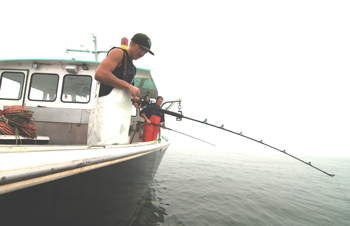Groundfish Hand Gear Looks Good in Preliminary Research
by Mike Crowe

Weighted jigs are dropped to the bottom for 5 minutes before being raised. Jigging is done 5 times at each station. Before 150' trawlers and dory tub trawls, ground fish were fished commercially with hand lines over the side. PERC photo
Researchers at the Stonington-based Penobscot East Research Center (PERC) conducted groundfish surveys in the Gulf of Maine in 2015 through a project titled the Eastern Gulf of Maine Sentinal Survey.
Results are encouraging—especially for a fishery that hasn’t seen much encouraging news for a few decades.
The surveys were designed by Maine ground fishermen, The Northeast Fisheries Science Center in Woods Hole, Mass., University of Maine/Orono marine biologist Yong Chen, and PERC.
The research includes the work of marine biologist and fisherman Ted Ames that goes back to 1994. His work includes cod spawning area studies, habitat and gear type research and broader considerations of the increasing abundance of prey fish such as alewives. Two dam removals on the Penobscot River are credited with helping increase alewive and other native anadromous fish passage going from a few hundred in 2012 to nearly 1 million in 2015. The resultant volume of young of year alewife prey fish available to groundfish would have been considerable.
“As we see stocks improve, we see that, with the proper regulations in place, a sustainable commercial groundfishery could survive,” said Patrick Shepard, a survey researcher. Current regulations would allow permit and quota-holders to return and fish out the area. A revived fishery would have to look different from the traditional fishery of the past, he said. All permits in Eastern Maine and most in the rest of Maine have moved south to Gloucester and New Bedford.
The sampling area is from the Penobscot River east to the Canadian border and from shore out to 45 miles. That area is divided into a grid of stations that are three nautical miles by three nautical miles. Depths range from shore shallows to 50 meters. There are two station selection processes. One is the Random Statistical Survey chosen by computer program. The second is fishermen’s choice, selected by fishermen’s knowledge and experience. The selection process avoids clustering stations in any one area.
Two gear types were used to compare efficiencies—longline and jigging. Jigging is more selective and longline brings in a greater variety of fish. Longlines have 2,000 hooks and are set for 2 hours in each station. Weighted jigs are dropped to the bottom for 5 minutes before being raised. Jigging is done 5 times at each station.
Future Sentinel Surveys will use only jig gear because longlines, some miles in length, can create gear conflicts with lobster traps and don’t function as well when focusing on a small area. Many fishermen in eastern Maine have moved away from longlines, except for halibut, and so younger fishermen are no longer familiar with the gear type.
The selection process includes looking at bottom type and the presence of fish. Atlantic cod, mackerel, pollock and halibut were targeted, but information on all groundfish species was gathered. Each fish caught is measured, weighed, and photographed. Photographs were sent to Graham Sherwood at the Gulf of Maine Research Institute, for morphometric analysis. Retained fish were sold by the fishermen in the Northeast Coastal Communities Sector who contracted to use their boats and run the gear.
Increasing the number of fish in a sample and reducing variation is critical, said Mattie Rodrigue, one of the researchers working on the project. Inshore areas produced the most encouraging results. In these waters, zero to 50 meters deep—a more complex bottom where the presence of lobster gear makes trawling impossible—there were more cod. Although the survey was relatively short, 4 years, it looks like inshore areas are rebuilding. Cod are long-lived and scientists said it’s possible the stock is reviving, but they also cautioned that the current time-series of data is still short and therefore not definitive.
Average abundance is calculated by totaling the number of fish caught and dividing that by the number of stations where those fish were caught. One goal is to increase relative abundance and decrease variation. This is necessary for the data to be useful to the larger federal assessment process.
The quantity, size and species-specific results were positive enough for researchers to foresee a limited commercial harvest if conditions improve. Habitat protections and the resurgence of prey fish like alewives is expected to continue to allow the groundfish resource to rebound. The use of hand gear only in some areas would stabilize groundfish habitat, more selectively remove fish, and virtually eliminate the controversial impacts of random bycatch, said Shepard.
